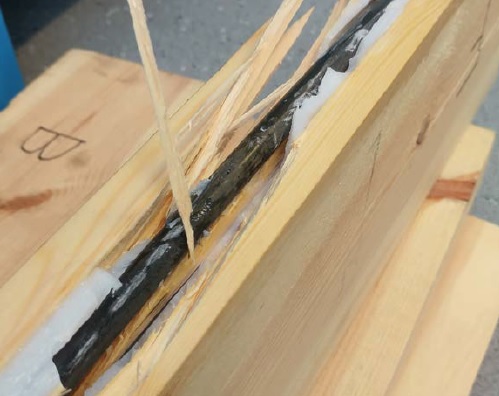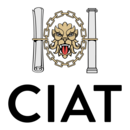In-situ reinforcement of timber beams

|
Conservative repair is a philosophy associated with William Morris and the manifesto he co-wrote in 1877 when the Society for the Protection of Ancient Buildings (SPAB) was formed. The premise is for repairing buildings rather than restoring so that its entire history is preserved.
In conservation, it is important to leave in place the historic fabric of the original building and therefore, with the assistance of retro-fitted in situ reinforcement, a minimal amount of intervention to the historic timber would occur allowing more to be retained for future generations.
By utilising the near surface mounting method, the amount of existing timber to be `lost` to allow the reinforcement to be installed is small when compared to the possibility that whole sections of authentic timber might need to be replaced as they are not strong enough to meet the current loading demands or need replacing due to deterioration of the building structure (rot, etc).
Alternative methods, like wrapping the timber in carbon fibre, similar to the way concrete columns/ beams have been strengthened, have seemingly been discounted. This is believed to be down to the inconsistency of a timber beam as it changes in size in relation to its water content (timber is a hygroscopic material, meaning it absorbs water). In other words, should the beam be wrapped when it has a high-water content, the reinforcement would become loose and not work effectively once the timber shrinks. Correspondingly, beams with low water moisture content would cause excessive strains on the reinforcement material if the timber absorbs more moisture and swells in size.
The aim of this study was to evaluate material for reinforcing timber beams from a conservation point of view. The materials used for the comparison are:
- • carbon fibre rod
- • glass fibre rod
- • steel threaded bar
To replicate awkward on-site conditions where there is the possibility of only partial sections of timber joists being accessible, the experiment involved 1.2m lengths of plain square edged timber (44mm x 146mm) which were machined with a groove 14mm deep x 14mm wide x 1m long. Nine sections of the timber were machined, with one length being left untouched to be used as a base strength model for correlation against the reinforced versions.
A thixotropic two-part structural adhesive was used to retain the reinforcing material in the slots. Thixotropic adhesive is particularly useful on overhead applications as the two parts, when mixed together, get thinner allowing easier application. The downside to the adhesive is the curing time of around 21 days.
The adhesive was first applied into the groove to fill it approximately three quarters full, the rod inserted and pushed to the bottom of the groove and then covered over with another layer of the adhesive.
Each timber joist had only one reinforcing rod inserted. There were three 10mm diameter glass fibre rods, three 10mm diameter carbon fibre rods and three M10 threaded steel bars in total.
After the joists had cured the strength testing took place in the university’s workshop using an Instron 5985 which is a universal, static testing system that can perform tensile, compression, shear, flexure, peel, tear, cyclic and bend tests. Each joist was supported at each end with measurements being taken at the mid span.
The results showed that the reinforcement increased the structural loading capabilities by an average 22.18% and the load deflection by 72.75% over the three materials. However, following the literature review, where it was expected that the carbon fibre reinforced joists would show the greatest increase in loading, a threaded rod example produced the highest loading results achieving 40.12KN. When compared to the glass fibre (37.43KN) and the carbon fibre (38.25KN) samples, it is unclear as to whether the additional cost for the glass fibre or carbon fibre rods can be justified, although this experiment did only use a very limited number of samples and further testing might generate different results.
The experiment also proved that the shape of the reinforcement material is important to create a strong bond with the structural adhesive and that the method of applying the adhesive could be open to variations. With smooth rods (glass fibre and the carbon fibre) the adhesive has only the circumference to adhere to whereas the threaded rod has the helical shape of the threads which dramatically increases the available area for the adhesive to `hold` on to. It was also noted that several of the timber joists had knots close to the loading points which would affect the results.
In summary, physically conducting the experiment has improved my understanding of how reinforcement works and the reinforced near surface mount method provides sufficient structural improvement with a low risk of harm to the timber and therefore would be viewed as a positive action for conservation of historic timbers.
[edit] Judge’s comments
A research area that is topical and important for Architectural Technology, retrofit design, conservation and sustainability. Clearly articulated with research methodology, aims and objectives and detailed robust and well-conceived experimental methods. A broad range of tests and materials deployed and an excellent presentation of all aspects of the report. An interesting subject and the use of experiments is very promising.
This article was written by Darren Nelson, University of Central Lancashire and won the Student Award For Excellence In Architectural Technology (Report) in the 2018 AT Awards. It first appeared in Architectural Technology Journal, Autumn 2018 issue.
--CIAT
[edit] Related articles on Designing Buildings Wiki
- Advantages and disadvantages of timber frame buildings.
- Alterations and extension to The Grange.
- Architectural Technology Awards 2018.
- Balloon framing.
- Concrete frame.
- Delivering sustainable low energy housing with softwood timber frame.
- Post.
- Sacrificial timber.
- Skeleton frame.
- Steel frame.
- Stud.
- Testing timber.
- The Institute of Historic Building Conservation.
- Timber.
- Timber framed buildings and fire.
- Timber post and beam construction.
- Timber preservation.
- Types of frame.
- Types of timber.
IHBC NewsBlog
Old Sarum fire in listed (& disputed) WW1 Hangar - Wiltshire Council has sought legal advice after fire engulfed a listed First World War hangar that was embroiled in a lengthy planning dispute.
UK Antarctic Heritage Trust launches ‘Virtual Visit’ website area
The Trust calls on people to 'Immerse yourself in our heritage – Making Antarctica Accessible'
Southend Council pledge to force Kursaal owners to maintain building
The Council has pledged to use ‘every tool in the toolbox’ if urgent repairs are not carried out.
HE’s Research Magazine publishes a major study of the heritage of England’s suburbs
The article traces the long evolution of an internal programme to research 200 years of suburban growth
IHBC Context 183 Wellbeing and Heritage published
The issue explores issues at the intersection of heritage and wellbeing.
SAVE celebrates 50 years of campaigning 1975-2025
SAVE Britain’s Heritage has announced events across the country to celebrate bringing new life to remarkable buildings.
IHBC Annual School 2025 - Shrewsbury 12-14 June
Themed Heritage in Context – Value: Plan: Change, join in-person or online.
200th Anniversary Celebration of the Modern Railway Planned
The Stockton & Darlington Railway opened on September 27, 1825.
Competence Framework Launched for Sustainability in the Built Environment
The Construction Industry Council (CIC) and the Edge have jointly published the framework.
Historic England Launches Wellbeing Strategy for Heritage
Whether through visiting, volunteering, learning or creative practice, engaging with heritage can strengthen confidence, resilience, hope and social connections.














